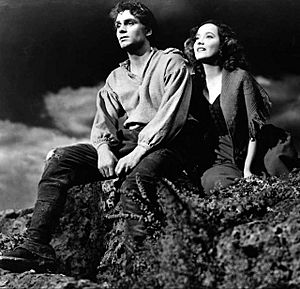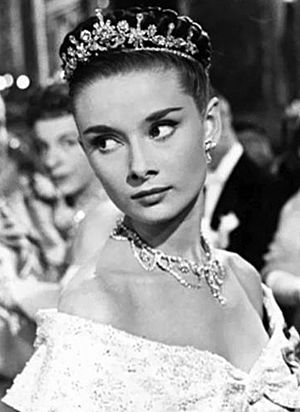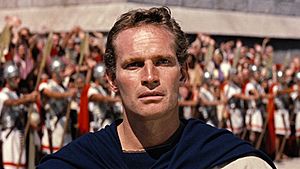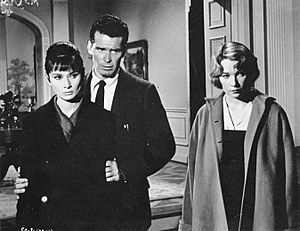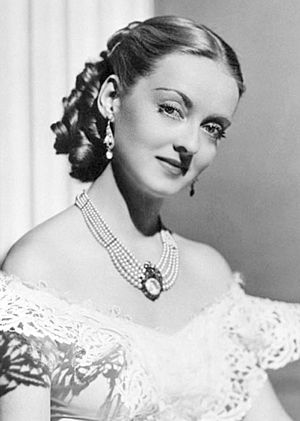William Wyler facts for kids
Quick facts for kids
William Wyler
|
|
|---|---|
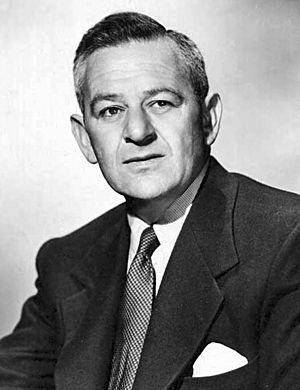
Wyler in 1945
|
|
| Born |
Willi Wyler
July 1, 1902 |
| Died | July 27, 1981 (aged 79) |
| Resting place | Forest Lawn Memorial Park, Glendale, California, U.S. |
| Occupation |
|
| Years active | 1925–1970 |
| Spouse(s) |
|
| Children | 5 |
| Relatives | Carl Laemmle Jr. (cousin) |
| Military career | |
| Allegiance | |
| Service/ |
|
| Years of service | 1921–1922 (National Guard) 1942–1945 (Army Air Forces) |
| Rank | |
| Unit | |
| Battles/wars | World War II
|
| Awards | |
William Wyler (born Willi Wyler; July 1, 1902 – July 27, 1981) was a famous Swiss-German-American film director and producer. He won the Academy Award for Best Director three times. These awards were for Mrs. Miniver (1942), The Best Years of Our Lives (1946), and Ben-Hur (1959). All three of these movies also won the award for Best Picture. He holds a record of twelve nominations for Best Director.
Wyler was born in Alsace, a region that was part of Germany but later became part of France. As a young person, he was known for being a bit of a troublemaker in school. In 1921, he moved to the United States. He started working for Universal Studios in New York before moving to Los Angeles. By 1925, he was the youngest director at Universal. In 1929, he directed Hell's Heroes, which was Universal's first sound movie filmed entirely outside a studio.
He helped many actors become stars. For example, he directed Audrey Hepburn in her first main role in Roman Holiday (1953). He also directed Barbra Streisand in her first movie, Funny Girl (1968). Both actresses won Academy Awards for these roles. Olivia de Havilland and Bette Davis each won their second Oscars in Wyler's films. Davis said Wyler made her a "far, far better actress."
Film expert Ian Freer called Wyler a "perfectionist." He was known for making actors do many takes of a scene to get it just right. His skill in directing classic stories made him one of Hollywood's most successful filmmakers from the 1930s to the 1960s. He won several major awards for his work, including the Irving G. Thalberg Memorial Award and the AFI Life Achievement Award.
Contents
Early Life and Moving to America
William Wyler was born into a Jewish family in Mulhouse, Alsace. At that time, Alsace was part of the German Empire. His father, Leopold, was born in Switzerland and started as a traveling salesman. Later, he owned a successful clothing store in Mulhouse. Wyler's mother, Melanie, was German-born. She was also a cousin of Carl Laemmle, who founded Universal Pictures.
During his childhood, Wyler went to many schools. He was known for being a "hellraiser" and was even expelled more than once for misbehaving. His mother often took him and his older brother, Robert, to concerts, opera, and the theatre. They also watched early movies. Sometimes, his family and friends would put on plays at home for fun.
Wyler was expected to take over his family's clothing business. After World War I, he worked for a year in Paris selling shirts and ties. He was very poor during this time. When his mother saw that he was not interested in the clothing business, she contacted her cousin, Carl Laemmle. Laemmle owned Universal Studios and often looked for young people to work in America.
In 1921, Wyler met Laemmle and was hired to work at Universal Studios in New York. Wyler said that "America seemed as far away as the moon." He traveled to New York on a ship with Laemmle. He and another young man, Paul Kohner, had to pay back the cost of their trip from their small weekly salary as messengers. After working in New York for several years, and serving in the New York Army National Guard for a year, Wyler moved to Hollywood to become a director.
Becoming a Film Director
Around 1923, Wyler arrived in Los Angeles and started working at Universal Studios. He cleaned stages and moved sets. He got his first big chance when he was hired as a second assistant editor. However, he sometimes played billiards or card games instead of working. After being fired and rehired a few times, Wyler decided to focus on becoming a director.
He started as a third assistant director. By 1925, he became the youngest director at Universal. He directed many westerns, which Universal was famous for. Wyler was so dedicated that he would even dream about "different ways (for an actor) to get on a horse." He sometimes joined the chase scenes in his own movies.
In 1928, he directed his first non-Western film, Anybody Here Seen Kelly?, which is now lost. Then he made his first films with some sound, The Shakedown and The Love Trap. He proved he was a skilled filmmaker. In 1928, he became a naturalized United States citizen. His first movie with all talking, Hell's Heroes, was filmed entirely on location in the Mojave Desert in 1929.
Directing in the 1930s
In the early 1930s, Wyler directed many different types of films at Universal. These included serious dramas like The Storm and A House Divided. He also directed comedies such as Her First Mate and The Good Fairy. He became known for asking actors to do many takes of a scene. This often led to actors giving amazing performances that won awards.
After leaving Universal, he started working with Samuel Goldwyn. For Goldwyn, he directed many classic films. These included Dodsworth (1936), These Three (1936), and Dead End (1937). He also directed Wuthering Heights (1939), The Westerner (1940), The Little Foxes (1941), and The Best Years of Our Lives (1946).
During this time, Wyler began working with cinematographer Gregg Toland. They helped create the "deep focus" style of filmmaking. This technique allowed many things in a scene, both close up and far away, to be in sharp focus at the same time. This made scenes look more realistic. Toland later used this technique when he filmed Orson Welles' Citizen Kane.
Bette Davis was nominated for three Oscars for her roles in Wyler's films. She won her second Oscar for her performance in Wyler's 1938 film Jezebel. She said that Wyler helped her become a "far, far better actress."
Laurence Olivier starred in Wyler's Wuthering Heights (1939). This role earned Olivier his first Oscar nomination. Olivier said Wyler taught him how to act for the screen, even though they sometimes argued. A critic from the New York Times wrote that William Wyler "directed it magnificently."
Director and screenwriter John Huston was a close friend of Wyler. Wyler hired Huston to work on a script after seeing his dialogue ideas. Wyler later inspired Huston to become a director and became his "early mentor." When America entered World War II in 1941, Wyler, Huston, and other directors joined the military.
Wyler's War Service and 1940s Films
In 1941, Wyler directed Mrs. Miniver. This film was about an English family dealing with the war in Europe and the bombing blitz in London. It starred Greer Garson and Walter Pidgeon. Pidgeon was unsure about taking the role, but he later said it was a wonderful experience. Garson won her first and only Academy Award for her performance.
The film was important because it aimed to make the U.S. less isolated from the war. By showing the suffering of British citizens, it hoped to make Americans more willing to help Britain. The film was very successful in showing Britain during its hardest times in the war. Mrs. Miniver won six Academy Awards and was the most popular movie of 1942. It was Wyler's first Academy Award for Best Director.
President Roosevelt and British Prime Minister Winston Churchill both loved the film. Roosevelt wanted copies sent to theaters quickly. The film's message was even broadcast on the radio and dropped as leaflets over German-occupied countries. Churchill sent a telegram saying that "Mrs. Miniver is propaganda worth 100 battleships."
Between 1942 and 1945, Wyler joined the United States Army Air Forces as a major. He directed two documentaries: The Memphis Belle: A Story of a Flying Fortress (1944) and Thunderbolt! (1947). Wyler filmed The Memphis Belle at great personal risk, flying on actual bombing missions in 1943. During one flight, he passed out from lack of oxygen. His cinematographer, Harold J. Tannenbaum, was shot down and died while filming.
While working on Thunderbolt!, Wyler was exposed to very loud noise and lost hearing in one ear. He later regained some hearing with a hearing aid. Wyler returned from the war as a lieutenant colonel and a disabled veteran.
After the war, Wyler directed The Best Years of Our Lives (1946). This film was about three veterans returning home from World War II and adjusting to civilian life. It was a very personal film for Wyler, as it reflected his own experience coming home. The Best Years of Our Lives won the Academy Award for Best Director (Wyler's second) and Academy Award for Best Picture, along with seven other Academy Awards.
In 1949, Wyler directed The Heiress. This film earned Olivia de Havilland her second Oscar. It also won Oscars for Best Art Direction, Best Costume Design, and Best Music. De Havilland saw the play in New York and felt she could play the main role perfectly. She called Wyler and convinced him to buy the film rights.
Films of the 1950s
In 1951, Wyler produced and directed Kirk Douglas and Eleanor Parker in Detective Story. This movie showed a day in the lives of people in a detective squad. Lee Grant and Joseph Wiseman made their first movie appearances in this film. It was nominated for four Academy Awards.
Roman Holiday (1953) introduced Audrey Hepburn to American audiences in her first main role. She won an Academy Award for Best Actress for this film. Wyler later said that truly great actresses like Hepburn are very rare. The film was an instant success, also winning for Best Costume Design and Best Writing. Hepburn would make three movies with Wyler, who her son said was one of the most important directors in her career.
Friendly Persuasion (1956) won the Palme d'Or (Golden Palm) at the Cannes Film Festival. In 1959, Wyler directed Ben-Hur. This movie won 11 Oscars, a record that was not matched until Titanic in 1997 and The Lord of the Rings: The Return of the King in 2003.
Wyler and the star of Ben-Hur, Charlton Heston, knew how important the film was for MGM studio. The movie's budget grew from $7 million to $15 million. They knew that if it failed, MGM might go bankrupt.
Making Ben-Hur was very difficult. Heston said he didn't enjoy any of it because it was such hard work. The movie had fifteen thousand extras and was filmed on special 70mm film. It was the most expensive film ever made at that time. For example, the nine-minute chariot race took six months to film.
Ben-Hur became a huge success at the box office. Wyler won his third Academy Award for Best Director, and Charlton Heston won his first Oscar as the star. Heston's agent told him, "Actors take parts with Wyler without even reading the script! You have to do this picture!"
Kirk Douglas wanted the main role, but Wyler had already chosen Heston. Douglas was offered another role, which he turned down. He then starred in Spartacus (1960). Ben-Hur cost $15 million to make but earned $90 million worldwide.
Later Career in the 1960s
In 1961, Wyler became a director for 20th Century Fox. He cast James Garner in The Children's Hour with Audrey Hepburn and Shirley MacLaine. Garner had won a lawsuit against Warner Bros., which allowed him to leave his TV series. This briefly made it hard for him to find work, but Wyler helped him by casting him.
In 1968, Wyler directed Barbra Streisand in her first movie, Funny Girl. It also starred Omar Sharif and was a huge financial success. The movie was nominated for eight Academy Awards. Like Audrey Hepburn, Streisand won Best Actress for her first starring role. She was the thirteenth actor to win an Oscar under Wyler's direction.
Streisand had already performed in the Broadway musical of Funny Girl many times. Wyler helped her change her stage performance for the movie screen. They got along well, even though she liked to be involved in the film's production. Wyler was drawn to Streisand because she was new to film audiences, similar to Audrey Hepburn. He saw that Streisand had the same strong dedication to acting as Bette Davis did early in her career.
Wyler was hired to direct Patton (1970) but left before filming began. The last film Wyler directed was The Liberation of L.B. Jones, released in 1970.
Wyler's Directing Style
Wyler worked with cinematographer Gregg Toland on six of his films, mostly in the 1930s. Toland often used a "deep focus" photography technique. This meant that all objects on the screen, both close up and far away, stayed in sharp focus at the same time. This technique made scenes look more realistic and added depth.
Wyler was a perfectionist. He earned the nickname "40-take Wyler" because he would often make actors repeat scenes many times. On the set of Jezebel, Wyler made Henry Fonda do 40 takes of one scene. His only direction was "Again!" When Fonda asked for more guidance, Wyler simply said, "It stinks."
Wyler's Lasting Impact
Fourteen actors won Oscars while working with Wyler. These included Bette Davis in Jezebel (1938). Davis said that Wyler "helped me to realize my full potential as an actress."
Other Oscar winners were Olivia de Havilland in The Heiress (1949), Audrey Hepburn in her first film, Roman Holiday (1953), Charlton Heston in Ben-Hur (1959), and Barbra Streisand in her first film, Funny Girl (1968).
Wyler's films received more awards for the people involved in them than any other director in Hollywood history. He was nominated for Best Director 12 times. Many of his co-workers and actors won or were nominated for Oscars. In 1965, Wyler won the Irving G. Thalberg Memorial Award for his career achievements. Eleven years later, he received the AFI Life Achievement Award. Besides his Best Picture and Best Director Oscar wins, 13 of Wyler's films were nominated for Best Picture.
Personal Life and Death
Wyler was briefly married to actress Margaret Sullavan from 1934 to 1936. He then married actress Margaret "Talli" Tallichet on October 23, 1938. They stayed together until his death and had five children: Catherine, Judith, William Jr., Melanie, and David. His daughter Catherine said that her mother was very important to his career, often helping him choose scripts.
On July 24, 1981, Wyler gave an interview with his daughter, Catherine. This interview was for Directed by William Wyler, a PBS documentary about his life. Three days later, on July 27, 1981, he died from a heart attack. He is buried at Forest Lawn Memorial-Park in Glendale, California.
Honors and Awards
William Wyler is the director with the most nominations in Academy Awards history, with twelve nominations. He won the Academy Award for Best Director three times: for Mrs. Miniver (1942), The Best Years of Our Lives (1946), and Ben-Hur (1959). He is tied with Frank Capra and is behind John Ford, who won four Oscars in this category.
He is also the only director in Academy history to direct three Best Picture-winning films (the same three for which he won Best Director). He directed more Best Picture nominees than anyone else, with thirteen films.
Wyler has the special honor of having directed more actors to Oscar-nominated performances than any other director in history: thirty-six. Out of these nominees, fourteen went on to win Oscars, which is also a record. He received the fourth AFI Life Achievement Award in 1976. Barbra Streisand was one of the actors who thanked him for directing her in her first film.
For his contributions to the movie industry, William Wyler received a star on the Hollywood Walk of Fame at 1731 Vine Street on February 8, 1960.
In 1961, Wyler was chosen as one of 50 outstanding Americans. He was honored as a Guest of Honor at the first annual Banquet of the Golden Plate in Monterey, California. This honor was given by the National Panel of Distinguished Americans of the Academy of Achievement.
| Year | Film | Category | Result | ||||
|---|---|---|---|---|---|---|---|
| Academy Awards | |||||||
| 1936 | Dodsworth | Best Director | Nominated | ||||
| 1939 | Wuthering Heights | Nominated | |||||
| 1940 | The Letter | Nominated | |||||
| 1941 | The Little Foxes | Nominated | |||||
| 1942 | Mrs. Miniver | Won | |||||
| 1946 | The Best Years of Our Lives | Won | |||||
| 1949 | The Heiress | Best Picture | Nominated | ||||
| Best Director | Nominated | ||||||
| 1952 | Detective Story | Nominated | |||||
| 1953 | Roman Holiday | Best Picture | Nominated | ||||
| Best Director | Nominated | ||||||
| 1956 | Friendly Persuasion | Best Picture | Nominated | ||||
| Best Director | Nominated | ||||||
| 1959 | Ben-Hur | Won | |||||
| 1965 | The Collector | Nominated | |||||
| Irving G. Thalberg Memorial Award | Won | ||||||
| Directors Guild of America | |||||||
| 1952 | Detective Story | Outstanding Directorial Achievement | Nominated | ||||
| 1954 | Roman Holiday | Nominated | |||||
| 1957 | Friendly Persuasion | Nominated | |||||
| 1959 | The Big Country | Nominated | |||||
| 1960 | Ben-Hur | Won | |||||
| 1962 | The Children's Hour | Nominated | |||||
| 1966 | Lifetime Achievement Award | ||||||
| 1969 | Funny Girl | Outstanding Directorial Achievement | Nominated | ||||
Images for kids
See also
 In Spanish: William Wyler para niños
In Spanish: William Wyler para niños


